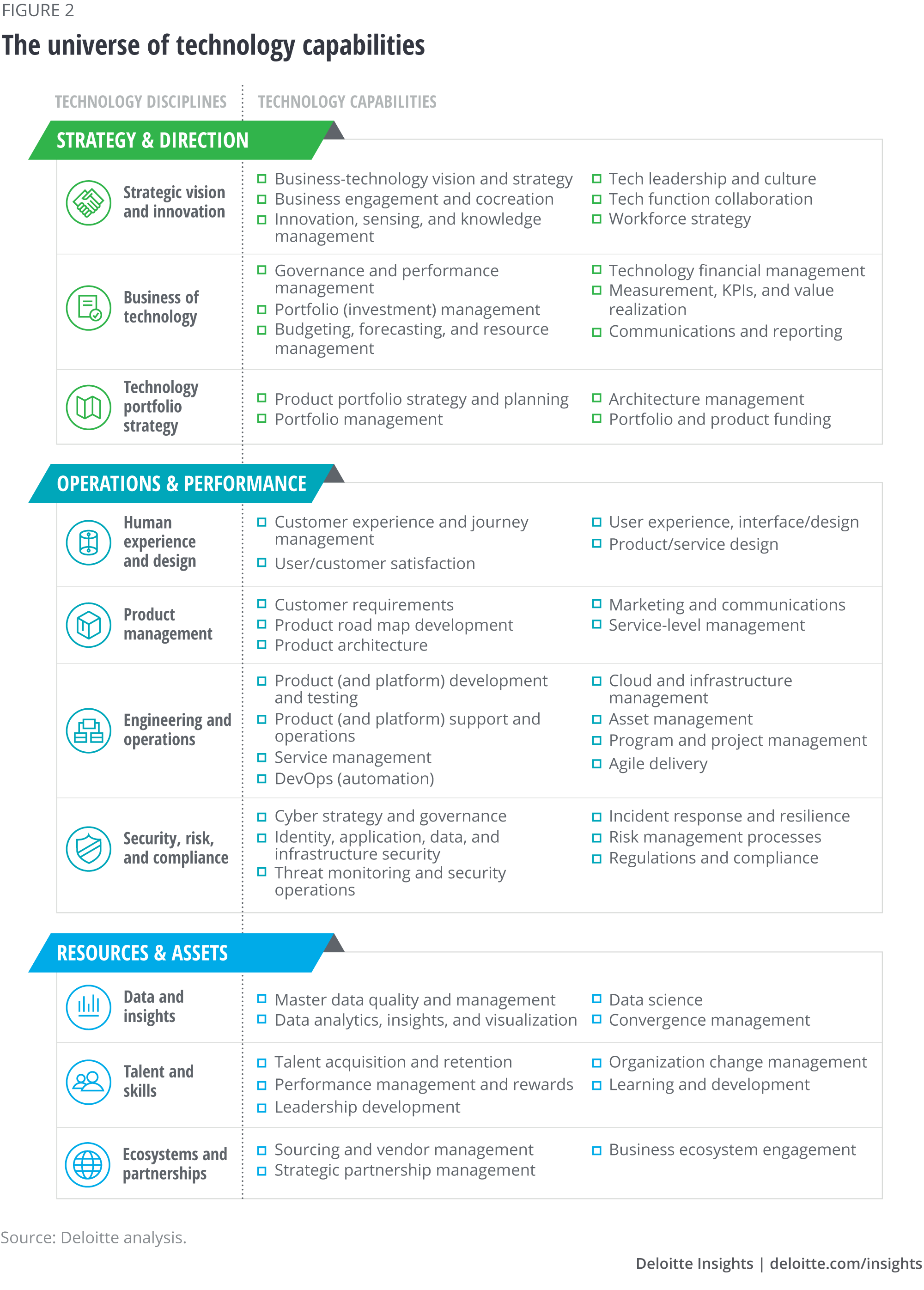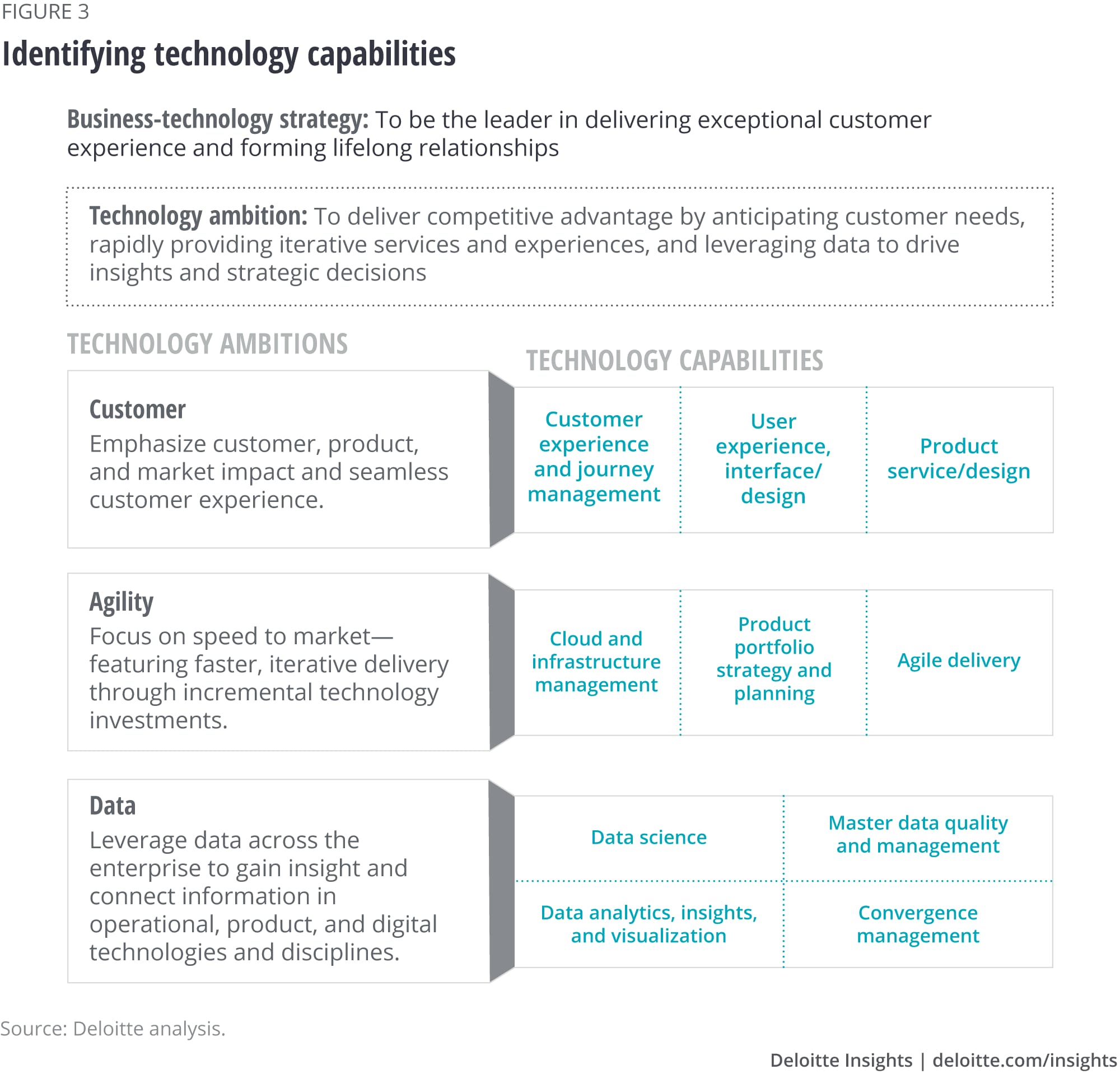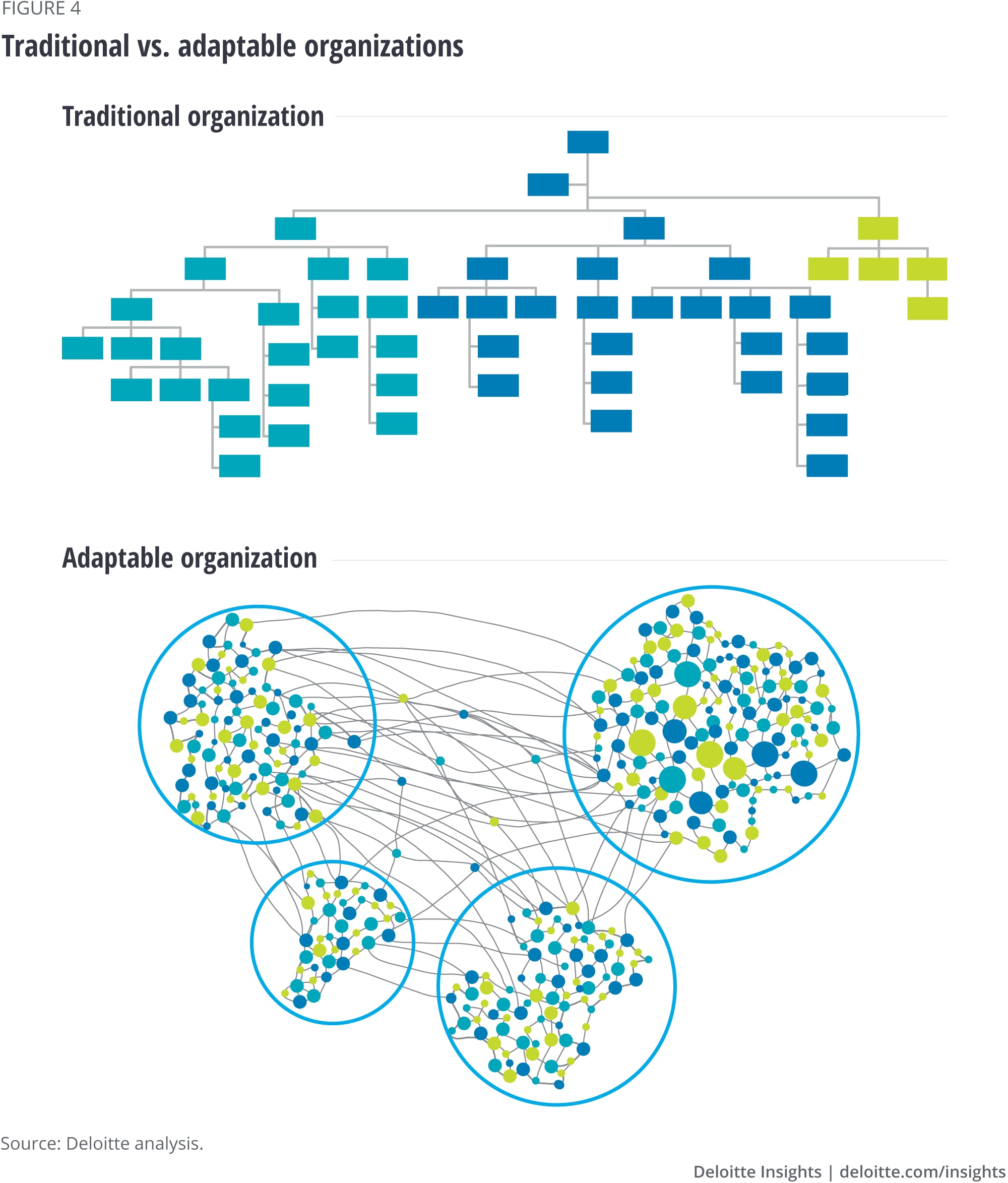
Reimagining the technology operating model How to design an agile and resilient technology function
15 minute read
07 May 2020
 Cindy Skirvin United States
Cindy Skirvin United States Nate Paynter United States
Nate Paynter United States Lisa Dubay-Albert United States
Lisa Dubay-Albert United States Suseela (CeCe) Kadiyala United States
Suseela (CeCe) Kadiyala United States
As technology reshapes traditional business practices and paradigms, organizations can remain competitive by being agile, collaborative, and customer-centric. The time may be ripe for reevaluating technology operating models.
Introduction
As business and technology strategies converge, the fortunes of the technology and business functions have also become entwined. Many savvy business and technology executives are already working together to reimagine how technology delivers business value and competitive advantage. To keep pace with this evolution, the technology function’s operating model should enable more agility, collaboration, and product and customer focus. This report will provide recommendations for developing and shifting to a new technology operating model.
Learn more
Explore the CIO Insider collection
Learn about Deloitte’s services
Go straight to smart. Get the Deloitte Insights app
Reevaluate traditional tech operating model constructs
In the past, many traditional technology operating model constructs stood in the way of innovation, agility, and collaboration. IT organizations often had top-down organization structures, with all technology functions rolling up under a single leader such as the CIO or CTO. Some talent served in specialized roles (e.g., IT service desk, application maintenance and support, network and infrastructure, and security), while others were grouped by skill set and assigned to various project teams. Applications were mostly developed in-house; infrastructure was managed in on-premise data centers. The historical IT function typically emphasized efficiency, consistency, security, and reliability.
The traditional model works well when the CIO’s mandate is to provide back-end tools and infrastructure. Today, the technology leaders’ mandate extends across the enterprise. As Satish Alapati, CIO of Media & Entertainment Customer Experience at AT&T, noted in a previous Deloitte report: “Because of technological advances, technology’s role within the organization is itself shifting. The role of technology has evolved from automating the business to actually being the business.”1
Migrating from these traditional constructs has made it easier for many companies to adapt to the following business, industry, and market changes:
- Speed to market. Traditional project delivery schedules and budgeting models reflect extended life cycles rather than fast speed to market. More flexible product- and customer-based models help manage volume and velocity that enable companies to respond to tech-driven market disruption by nimble, digitally native competitors.
- Cocreation of business solutions. To support the high level of collaboration needed to cocreate value in conjunction with business units, technology functions can benefit from operating models that eliminate top-down bureaucracies and organizational silos.
- Increased customer expectations. Ubiquitous customer-centric experiences lead to high employee, customer, and partner expectations, requiring enterprises to be customer-obsessed. Organizations with product- and customer-centric technology operating constructs may find it easier to meet these demands than those relying on technology operating models developed primarily to manage back-office technologies.
- Platform economy. Digital platforms such as Airbnb and Amazon connect customers with products and services. They disrupt existing business models by shifting value from the producers to the platform. To deliver on the promise of technology platforms, the technology operating model should be agile and enable collaboration.
Emphasize fluidity, value creation, and resilience
Because each executive likely has his or her own ideas about the definition of an operating model and how to adjust it, operating model transformations can lead to widespread confusion and disagreement. To many people, operating model transformation is associated with cost takeout or organizational redesign, resulting in hierarchical “box-and-wire diagrams” that suggest a singular target state.
However, successful operating model revamps are typically complex, context-driven, and designed for fluidity, supporting multiple modes of operation working in conjunction. In our view, an operating model is a representation of how an organization creates value, who creates it, and the cost to deliver it,2 a point of view that may prevent technology executives from getting tangled in terminology or scope discussions. Instead, they can set their sights on developing a technology operating model design optimized for value creation and aligned with the organization’s business strategy.
As organizations embrace and adapt to business, industry, and market changes, it’s important to recognize that current operating models are deeply rooted in existing structures and definitions—and in the organic nature of work that has been established and reinforced over time. Changing them—for example, to accommodate a faster speed to market or the platform economy—can require intentional focus.
We propose that technology leaders consider five key elements for reimagining the technology operating model. The first two elements—business-technology strategy and technology ambition—can be considered the basic building blocks. The next three elements focus on how the technology function delivers value through various technology capabilities, operates across multiple modes, and drives organizational transformation (figure 1).

Align business-technology strategy and technology ambition
Aligning the technology function’s ambition and value creation with a business-technology strategy can be a critical first step. Together, clarity and alignment on the role and value of technology will serve as the polestar of the operating model transformation.
Traditionally, CIOs have been tasked with aligning the technology operating model with the business operating model. Our process instead assumes that the technology function will codevelop a joint business-technology strategy that can help leaders identify and envision a technology ambition, eliminating the need for standalone business and technology strategies.3
Business-technology strategy. Developing an overarching business strategy can be challenging because it requires leaders to make difficult choices about how to compete and win. The strategic choice cascade, a framework developed by A.G. Lafley and Roger L. Martin, can help leaders view strategy as a set of interrelated choices: What are the organization’s strategic aspirations? Where will it compete? How will it win?4 For example, the strategic choice cascade can help leaders understand trade-offs and make decisions about strategic technology levers, how to create value through technology (e.g., customer experience, product innovation, and business analytics), how technology can shape the organization, and to what extent the technology function should balance value creation with operational resilience. Using the strategic choice cascade or other methods to develop a business-technology strategy can help each business function remain aligned on mission and vision.
Once established, this strategy can help leaders envision the organization’s technology ambition.
Technology ambition. Although every organization’s context is different, in our experience, technology can primarily deliver value in six ways.
- Strategy: Prioritize technology to directly shape business strategy, mission, and vision by creating or enhancing products and services and delivering competitive advantage.
- Data: Leverage data across the enterprise to gain insight and connect information in operational, product, and digital technologies and disciplines.
- Agility: Focus on speed to market—featuring faster, iterative delivery through incremental technology investments.
- Customer: Emphasize customer, product, and market impact and seamless customer experience.
- Automation: Automate business operations, processes, infrastructure, and applications.
- Business of IT: Deliver reliable, resilient technology environments; ensure flow of information for effective decisions; manage talent sources, ecosystems, and partners; and increase return on technology investments.
An organization’s technology ambition is how it chooses to use these six levers to deliver value. Each of these levers is uniquely important, leading some leaders to pursue all of them simultaneously. However, we recommend focusing efforts on two or three areas where technology can help deliver a key competitive advantage and help the organization maximize value. This doesn’t mean that other areas are unimportant or should be ignored altogether.
A solid business-technology strategy and technology ambition serve as the foundation for reimagining the technology operating model. Clarity and focus in these two areas will allow organizations to identify and develop technology capabilities, pursue modes of operation, and engage in organizational transformation efforts that will maximize value.
Core technology capabilities support business-technology strategy and technology ambition
Technology capabilities—proficiencies such as architecture management, talent acquisition and retention, and data science, among many others—can enable the company to achieve its technology ambition. Organizations may have hundreds of technology capabilities, but in our experience, the following 10 core technology disciplines encompass most of the capabilities delivered through the technology function (figure 2).

Identifying capabilities that best support the organization’s strategy and ambition can be complex and challenging. The first step is to take an inventory of the organization’s existing capabilities and assess its current level of maturity across these capabilities.
The next step is to determine capabilities that will be critical to strategy and technology ambition—not all are equal. In our experience, the Pareto principle applies—80 percent of the value generated by technology is delivered through 20 percent of the capabilities. Look for those that stand out as drivers to achieving the technology ambition. Some of these capabilities may be mature, others may be nascent, and some may not exist. The information gleaned during this analysis can help CIOs determine whether they need to build, buy, upgrade, or temporarily acquire capabilities from a service provider or partner.
In a hypothetical example, a large retail business completes the strategic choice cascade process and develops a business-technology strategy to be “the leader in delivering exceptional customer experience and forming lifelong relationships.” Multiple technology ambitions could enable this strategy to succeed. Ultimately, the retailer decides to focus on customers, agility, and data to “deliver competitive advantage by anticipating customer needs, rapidly providing iterative services and experiences, and leveraging data to drive insights and strategic decisions.” The retailer then assesses current technology capabilities, determines future requirements and identifies gaps between the two, and ascertains technology capabilities that enable it to cultivate this technology ambition (figure 3).

Modes of operation optimize delivery of technology capabilities
In the past, many CIOs tried to adhere to a single technology operating model. Today, no one-size-fits-all operating model can meet the challenges of a dynamic organization. Leaders need not fixate on a single mode of operation or be satisfied with a bimodal approach. Nor should they view these modes as a continuum or as steps on a maturity scale.
Rather, the fast-moving environment dictates a more fluid and evolving operating construct, one that accommodates a changing blend of existing, emerging, and new technology capabilities. Each organization will likely blend multiple modes based on specific business needs, market conditions, and business capability requirements.
Understanding possible modes of operation can help technology leaders determine the optimal delivery of each capability. With a firm grasp of strategy, technology ambition, and capabilities, they can begin to embrace multiple modes of operation by aligning the most effective mode of operation to each capability, especially the ones that support strategy and ambition.
To operate in a truly multimodal environment, organizations will need to operate across the spectrum of these modes to deliver value. Conventional operating models with specialized and siloed IT teams supporting traditional delivery (i.e., waterfall) worked well for many years, maximizing economies of scale and operating and cost efficiencies, as well as employing stages and milestones that are clearly defined and delivered sequentially, leading to longer cycle times for achieving the desired value. Capabilities that require methodical, sequential, and nontime-sensitive delivery remain candidates for such traditional delivery models.
Hybrid mode: Balance new and legacy technologies
A hybrid mode of operating aims to reduce the dependence on legacy technologies and traditional domain-based models. Organizations may be dipping their toes into cloud-based services, using Agile methods and tools, eventually adopting digital and cloud platforms more extensively. For example, 80 percent of participants in a forthcoming Deloitte study of technology and business leaders indicated that digitization of business operations will have the biggest measurable impact in the next three years.5
Business and technology functions are more closely aligned, but functional domains may still exist. Technology is no longer seen solely as a service provider; it’s viewed instead as a business enabler or a trusted business adviser. Technology teams may be cautiously experimenting with product-centric technology delivery.
Due to entrenched legacy systems and processes, many technology organizations are currently delivering most of their capabilities in the hybrid model.
Product-based mode: Cocreation with business partners
Predominant among cloud-native companies that lack legacy technologies and platforms, a product-based mode of operating is a more flexible, scalable, fast, and cost-effective way to deliver technology capabilities.
The build-and-run functions are delivered by product teams jointly staffed by IT and business talent and focused on business outcomes. Business functions are highly engaged in IT delivery and held accountable for the results, and resources flow freely between IT and its business partners. The tighter integration of business and IT staff can help reduce functional silos; similarly, access to self-service capabilities can help decrease shadow IT. In this mode, the emphasis is more likely to be on product and service creation with business partners than on management of software licenses, data center infrastructure, or applications.
Borderless mode: Continuous integration and delivery
A borderless technology mode effectively eliminates the boundaries between technology and business functions. Dedicated groups of business and technology talent with the necessary skill sets focus on creating, enhancing, and delivering value; they leverage automation and create continuous and integrated delivery of product updates.
The borderless mode is not suitable for products and services traditionally supported by the technology function. Products such as collaboration tools and ERP systems that are used across the enterprise may benefit from centralized maintenance, management, and operations and economies of scale—and will likely continue to be managed and delivered by a core central technology function.6
However, the borderless mode may be appropriate for delivering capabilities where the technology function is cocreating value and driving experimentation and innovation or where time to market is a key driver.7 For example, as retailers and consumer products companies go to market through new channels that are less reliant on functional lines of business, they’re establishing borderless product management, engineering, and human experience capabilities.
The most effective technology operating models will likely combine many of the above modes and accommodate others, integrating business and technology functions, accelerating product and solution delivery, making it easier to understand and respond to the voice of the customer, and delivering cost-efficient, reliable, and high-quality services.
Organization transformation: Organization design, workforce ecosystem, and culture
To fully capitalize on the new technology operating model, the organization should transform across multiple dimensions. This includes redesigning organization structure, embracing a broad workforce ecosystem, and rethinking culture. During such a transformation, effective technology leaders are needed to tenaciously steer the organization in the right direction, deliver change, and pursue business value.
Adaptable organization design
As collaboration between business and technology functions increases, technology leaders may seek flexible organizational structures that capture informal behaviors and interactions and promote engagement with a larger external ecosystem. Adaptable organizations prioritize and embrace the human element in organizational design, including the ways people work together, informal relationships and networks, and customer input and feedback. These organizations are designed to acknowledge and leverage formal systems as well as informal networks—the relationships, power, political connections, and communications that usually have more influence than formal systems over behavior and outcomes (figure 4).

When technology organizations acknowledge that networks can exist internally, in business functions, and in broader business and technology ecosystems, they can build multidisciplinary teams, communities, reporting relationships, and communication channels that support natural human interactions. These cross-functional teams and relationships can establish direction, missions, and value statements that align directly with the organization’s overarching strategy. This can enable even the largest global organizations to operate with agility and a mission-and-value orientation.
Although some businesses tackle organizational design as the first step in the operating mode redesign process, we recommend taking it on toward the end of the process. Encourage virtual, fluid, collaborative team structures rather than static, solid-line relationships.
Workforce ecosystem: Expand beyond outsourcing
Continually evolving technology capabilities, the shift in delivery models, and the emergence of the workforce ecosystem are helping redefine technology roles. Fueled by automation, cloud, and cognitive technologies, specialized technical skills will likely continue to change and be in high demand, requiring significant workforce planning. This will include decisions about whether to develop skills internally or access them through the broader workforce ecosystem—especially for key capabilities aligned to its technology ambition. Many companies create multiple paths—acquisition, development, outsourcing, or partnership—for strategically sourcing talent with these differentiating skills. Technology leaders may decide to deploy third-party talent for critical, nascent capabilities, with the intent to train internal staff and shift resources internally over time.
Soft skills—enduring, essentially human skills that cannot be replicated by machines—complement technical expertise. As they become equal partners in value cocreation, technology organizations are likewise becoming more dependent on key human skills, including creativity, cognitive flexibility, and emotional intelligence—the three soft skills that technology leaders expect will increase the most in importance over the next three years.8 Managing and acquiring these soft skills can help organizations manage the increasingly complex workforce ecosystem.9
In addition to the need for skills, fluctuating talent demand—with projects that begin and end based on value orientation—can create a need for flexible capacity across the greater workforce ecosystem. Because the half-life of a skill is only five years,10 talent will need adequate learning and retraining opportunities to acquire and upgrade skills that will allow them to move into new and emerging roles.
Well-designed technology organizations are positioned as a fluid part of this network and can create value by building, managing, and governing their external talent ecosystem. In an integrated world where organizations are serving clients, competitors, and business partners simultaneously, they should maintain a razor-sharp focus on the customer, worker experiences, and real-time market information. Because of its extensive external reach, the workforce ecosystem can help the organization actively sense fluctuating industry and market trends and customer needs, behaviors, and requirements.
Culture: Adapt to the new normal
Business and technology executives cite inflexible culture, complacency, and lack of agility as the biggest threat to digital growth and maturity.11 And Deloitte’s 2018 global CIO survey finds that culture—the organization’s behavior and beliefs—distinguishes businesses that are more advanced than their peers. These more advanced organizations lean heavily on their organizational cultures to recruit and hire technical talent.12
As internal silos fall, operating models and organizational designs evolve, and businesses increase their engagement with the external talent ecosystem, traditional technology cultures will probably need to undergo an intentional, dramatic shift. To encourage innovation and collaboration—and to help acquire and retain top technology talent—organizational cultures should be adaptable, supportive, and engaging. As they strive to attract talent with soft skills such as empathy, creativity, cognitive flexibility, and emotional intelligence, technology leaders can nurture and curate a culture aligned with desired behaviors and outcomes.
Existing incentives, behaviors, policies, mandates, and management should support the new technology operating model and promote productivity, agility, or growth. For example, iterative work processes, commonly found in Agile environments, can benefit from rolling budget cycles and ongoing performance reviews.
Technology leaders have a critical role to play in operating model transformation. The vision they establish and day-to-day work practices they instill and reinforce can determine how the organization’s culture evolves and whether it supports or prevents the operating model from delivering on the promise of the joint business-technology strategy and technology ambition.
Key recommendations
- Take an agile, iterative approach. When transforming your technology operating model, define the target state and identify the minimum viable product necessary to get started. Then implement, operate, adjust, and expand to progress the transformation toward the desired target state. Don’t try to do everything at once and don’t expect it to quickly fall in place. This is an iterative process that will likely require a few rounds.
- Define and monitor success metrics. Because operating model transformation is likely a multiyear effort with many simultaneously moving parts, it’s important to break down the execution into small manageable chunks and establish associated goals and success metrics. For example, a large pharmaceutical company measured the effectiveness of its new technology operating model by tracking the number of innovation ideas submitted by technology staff, while a financial services company evaluated success using an internal net promoter score for IT.
- Be creative in building new capabilities. It can be challenging to create a net-new capability using existing staff and processes. Some strategic and emerging capabilities are best incubated in-house but for others, it’s easier to use new talent with the experience to build this capability or acquire it from a service provider or partner, depending on how critical the capability is to the business-technology strategy. For example, the CIO of a large manufacturing company didn’t have the budget to build a data science capability, so he developed a partnership with a local university and leveraged graduate students to help establish internal technologies and processes and train company staff.
- Differentiate between vendors and ecosystem partners. There’s a difference between the value and services provided by traditional vendors and those delivered by ecosystem partners. An energy company CIO describes his philosophy: “I have many technology vendors. They provide commodity services. I have no loyalty to any single provider and often select the lowest cost provider,” he says. “However, I only have a few partners. They help support innovation and value-creation projects. I choose them wisely and am loyal to them, and I consider them to be my thought partners. I usually don’t negotiate with them.”
- Design for both formal and informal structures, networks, and relationships. Understand and design for both formal and informal or hidden organizational structures; efforts to innovate within the formal system can often be constrained by the realities and resistance of the shadow system. When a technology company’s traditionally structured IT function discovered its customers initiated over 60 percent of interactions, it restructured its teams to be more proactive. This included redesigning roles to allow staff to be closer to customers and operate with more speed. The company also eliminated silos by identifying four informal organizational communities and regrouping teams to correspond with these four groups.
- Organize teams and empower them to be self-reliant. Customer-focused missions, connected to the larger organizational purpose and aligned to competitive differentiation, can help inspire and unite teams and leverage their natural tendency to self-optimize. Make teams self-reliant and try not to structure missions so that teams are dependent on each other’s success. Finally, link each mission to a measurable outcome.
- Architect for speed. As teams innovate and realize both successes and fast failures, organizational delivery speed will continue to accelerate. Technology leaders will need to overcome the challenges that legacy systems, traditional project management techniques, and complex integrations pose to speedy delivery. Architecting the technology environment to be responsive, iterative, and scalable will likely require migrating to the cloud, automating manual technology operations, and establishing a product mindset across technology and business functions.
- Manage the evolving operating model through iterative changes in culture. Major shifts in culture and mindset are often needed to maintain lasting operating model changes. Old habits die hard without constant reinforcement of new ones. Model and reward behaviors that drive collaboration, transparency, and value orientation. For example, a retail CIO sent a strong signal to the technology function by hiring two new direct reports whose backgrounds helped demonstrate new expectations.
- Find supportive enterprise sponsors. A technology operating model transformation can have an impact on the entire enterprise, requiring more involvement and accountability from business functions. Executive sponsors that understand and support the value and goals of the operating model revamp can help technology leaders gain internal backing and overcome challenges.
© 2021. See Terms of Use for more information.
More in CIO Insider
-
Beyond innovation by shotgun Article5 years ago
-
Technology and the boardroom: A CIO’s guide to engaging the board Article6 years ago
-
Trends in CIO reporting structure Article6 years ago
-
Technology budgets: From value preservation to value creation Article7 years ago
-
Manifesting legacy: Looking beyond the digital era Collection6 years ago













